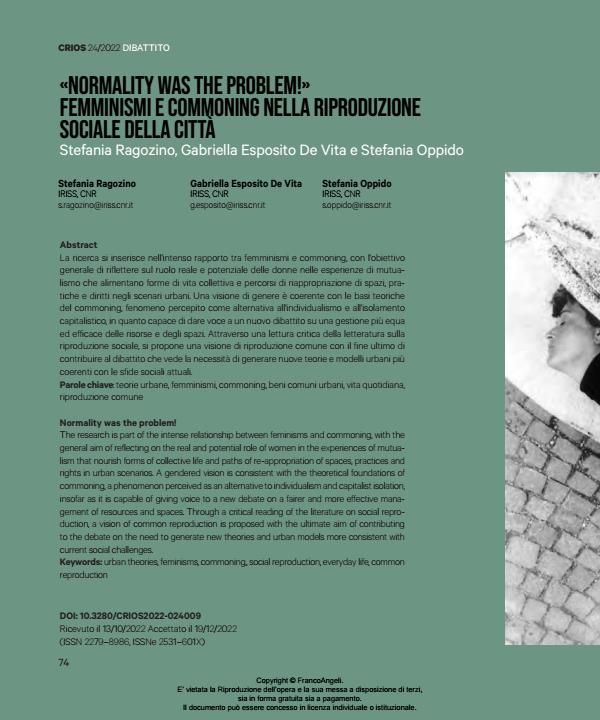«Normality was the problem!» Femminismi e Commoning nella riproduzione sociale della città
Titolo Rivista CRIOS
Autori/Curatori Stefania Ragozino, Gabriella Esposito De Vita, Stefania Oppido
Anno di pubblicazione 2024 Fascicolo 2022/24
Lingua Inglese Numero pagine 8 P. 74-81 Dimensione file 595 KB
DOI 10.3280/CRIOS2022-024009
Il DOI è il codice a barre della proprietà intellettuale: per saperne di più
clicca qui
Qui sotto puoi vedere in anteprima la prima pagina di questo articolo.
Se questo articolo ti interessa, lo puoi acquistare (e scaricare in formato pdf) seguendo le facili indicazioni per acquistare il download credit. Acquista Download Credits per scaricare questo Articolo in formato PDF

FrancoAngeli è membro della Publishers International Linking Association, Inc (PILA)associazione indipendente e non profit per facilitare (attraverso i servizi tecnologici implementati da CrossRef.org) l’accesso degli studiosi ai contenuti digitali nelle pubblicazioni professionali e scientifiche
The research is part of the intense relationship between feminisms and commoning, with the general aim of reflecting on the real and potential role of women in the experiences of mutualism that nourish forms of collective life and paths of re-appropriation of spaces, practices and rights in urban scenarios. A gendered vision is consistent with the theoretical foundations of commoning, a phenomenon perceived as an alternative to individualism and capitalist isolation, insofar as it is capable of giving voice to a new debate on a fairer and more effective management of resources and spaces. Through a critical reading of the literature on social reproduction, a vision of common reproduction is proposed with the ultimate aim of contributing to the debate on the need to generate new theories and urban models more consistent with current social challenges.
Parole chiave:teorie urbane, femminismi, commoning, beni comuni urbani, vita quotidiana, riproduzione comune
- Computational Science and Its Applications – ICCSA 2025 Workshops Stefano Cuntò, Lorenzo Lodato, Federica Morra, Stefania Ragozino, Maria Cerreta, pp.321 (ISBN:978-3-031-97659-9)
Stefania Ragozino, Gabriella Esposito De Vita, Stefania Oppido, «Normality was the problem!» Femminismi e Commoning nella riproduzione sociale della città in "CRIOS" 24/2022, pp 74-81, DOI: 10.3280/CRIOS2022-024009